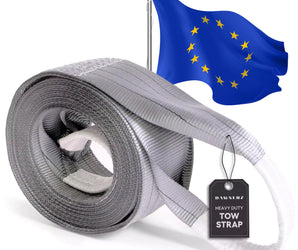Best Practices
This guide outlines recommended practices for the safe and effective use of synthetic web tie downs. It is based on the information provided by the Web Sling & Tie Down Association (WSTDA) but is not a substitute for consulting the manufacturer's instructions and applicable regulations.
Introduction
The Web Sling & Tie Down Association (WSTDA) develops recommended standards and reference materials for the synthetic web sling and tie-down industry. This manual provides a general overview of recommended procedures and operating practices. However, it is not exhaustive, and users should always consult the manufacturer for specific product and application information. The WSTDA disclaims responsibility for the actual use of synthetic web tie-down products.
Synthetic Web Tie Downs
A "web tie down" refers to a synthetic webbing assembly, with or without hardware, used to secure cargo. Tie downs not conforming to this manual should be used according to the manufacturer's instructions. Safety is paramount. Users must select appropriate tie downs, understand cargo securement methods, and comply with all relevant regulations.
Identification
Each tie-down assembly must be durably marked with the following information:
- Manufacturer's name and/or trademark
- Working Load Limit (WLL) in pounds and kilograms
- Use, inspection, and warning instructions
Recommended Operating Practices
Proper Selection
- Choose tie downs suitable for the load, environment, and vehicle anchor points.
- Ensure fittings are the correct size and shape.
- Identify the WLL of both the tie down and the anchor points; the lower of the two determines the system's WLL.
- Determine the necessary number of tie downs based on cargo weight, commodity type, the aggregate WLL, and the cargo's length/weight ratio. Consider tie-down angles.
- Comply with commodity-specific regulations from organizations such as the Federal Motor Carrier Safety Administration.
Use and Care
- Never exceed the WLL. Account for the angle of the tie down, as it affects downward pressure.
- Attach tie downs according to applicable regulations to prevent shifting.
- Always protect tie downs from sharp edges, corners, and abrasive surfaces using appropriate edge protection.
- Do not shorten, join, repair, or lengthen tie downs by knotting.
- Tie downs designed for securing cargo should not be used for lifting, towing, or other unintended purposes.
- When using winch or ratchet straps, maintain 2-4 wraps of webbing on the mandrel.
- Maintain secure footing when operating tie downs. Exercise extra caution in adverse weather.
- Regularly inspect and adjust tie downs during transit according to regulations.
- Avoid pulling tie downs from under cargo.
- Do not drop or drag tie downs on abrasive surfaces.
Environmental Considerations
- Store tie downs in a cool, dry, dark place to prevent UV degradation.
- Consult the manufacturer regarding chemical compatibility in chemically active environments.
- Avoid using aluminum fittings where alkalis or acids are present.
- Be aware of the potential for degradation from acids and alkalis, considering the type, exposure conditions, concentration, temperature, and duration of exposure.
- Do not use nylon or polyester webbing tie downs at temperatures exceeding 194°F (90°C) or below -40°F (-40°C).
- Minimize UV exposure by storing tie downs properly and considering protective coatings.
- Regularly inspect and clean tie downs, rinsing with clean water and lubricating hardware as needed. Avoid chlorine-based cleaners on aluminum.
- Washing tie down webbing is not recommended.

